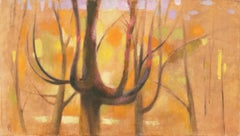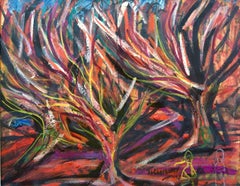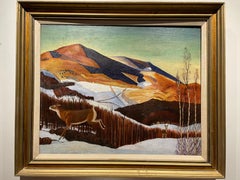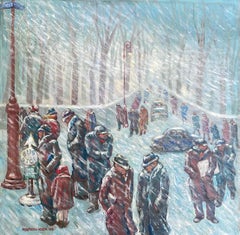1950s Landscape Paintings
Period: 1950s
Color: Orange
'Trees at Sunset', Large Oil, Philadelphia Museum, Yale, PAFA Op-Ed Woman Artist
Located in Santa Cruz, CA
Signed, lower left, with monogram, 'E. A.', for Edna Wright Andrade (American, 1917-2008) and dated 1954. Additionally signed, verso.
A luminous, mid-ce...
Category
Op Art 1950s Landscape Paintings
Materials
Canvas, Oil
"Fireglow Sunset"
Located in Southampton, NY
Oil on artist board mounted on wood panel. Tschacbasov sunset sets the trees ablaze in this beautiful painting done in the late 1950's while two small figures in the lower right side...
Category
American Modern 1950s Landscape Paintings
Materials
Oil
Related Items
Vintage Rockwell Kent Copy of "Vermont Winter 1921" Oil on Canvas Painting, 1960
Located in Baltimore, MD
This large painting is a ca. 1960 copy of a famous Rockwell Kent painting that was executed in Vermont in 1921. The work is oil on canvas and well represents the original image, tho...
Category
American Modern 1950s Landscape Paintings
Materials
Oil
H 25 in W 30 in D 3 in
Waiting for the Bus in a Blizzard- WPA American Scene 1938 NYC Modernism Realism
By Maurice Kish
Located in New York, NY
Waiting for the Bus in a Blizzard- WPA American Scene 1938 NYC Modernism Realism. 16 x 16 inches, Oil on board, Signed and dated 1938 lower left.
...
Category
American Modern 1950s Landscape Paintings
Materials
Oil, Board
"Winter" American Modernism WPA Regionalism Landscape Mid-Century Magic Realism
By Dale Nichols
Located in New York, NY
"Winter" American Modernism WPA Regionalism Landscape Mid-Century Magic Realism. 30 x 40 inches. Oil on canvas, c. 1960s, Signed lower right.
As we list the painting now, the work is currently being cleaned, restored and a hand carved frame is being built. Additional photos will be uploaded as soon as possible.
Our gallery, Helicline Fine Art, just launched our new digital exhibition: American Art: The WPA and Beyond. Three dozen paintings, works on paper and sculptures which are available here on 1stDibs. In person viewings can be arranged by appointment at our midtown Manhattan gallery.
Provenance:
"Winter" was originally purchased by Stanley Byer. Mr. Byer owned homes in Key West, New York City, and Washington, D.C. He purchased the painting from Dunning Auction in 1984 in Elgin, Illinois. Mr. Byer was related to Abraham Weiss from Florida. Saul Babbin, now deceased was a cousin of Mr. Weiss. I purchased the painting from Joy Babbin, Mr. Babbin's wife, now living in from New Mexico.
Dale Nichols (1905 – 1995) Artist, printmaker, illustrator, watercolorist, designer, writer and lecturer, Nichols did paintings that reflected his rural background of Nebraska where he was born in David City, a small town. Although he did much sketching outdoors, most of his paintings were completed in his studio and often included "numerology, magic squares...
Category
American Modern 1950s Landscape Paintings
Materials
Oil, Canvas
Vintage Southwest (California?) Impressionist Painting, Lily S. Converse ca 1940
Located in Baltimore, MD
This is a very stylized Southwest landscape that appears to document a small church that existed at one time, perhaps in the Palm Springs or Santa Fe area. It is very reminiscent of...
Category
American Modern 1950s Landscape Paintings
Materials
Oil
Early oil depicting the Great Fire of London
Located in London, GB
The Great Fire of London in September 1666 was one of the greatest disasters in the city’s history. The City, with its wooden houses crowded together in narrow streets, was a natural fire risk, and predictions that London would burn down became a shocking reality. The fire began in a bakery in Pudding Lane, an area near the Thames teeming with warehouses and shops full of flammable materials, such as timber, oil, coal, pitch and turpentine. Inevitably the fire spread rapidly from this area into the City. Our painting depicts the impact of the fire on those who were caught in it and creates a very dramatic impression of what the fire was like. Closer inspection reveals a scene of chaos and panic with people running out of the gates. It shows Cripplegate in the north of the City, with St Giles without Cripplegate to its left, in flames (on the site of the present day Barbican). The painting probably represents the fire on the night of Tuesday 4 September, when four-fifths of the City was burning at once, including St Paul's Cathedral. Old St Paul’s can be seen to the right of the canvas, the medieval church with its thick stone walls, was considered a place of safety, but the building was covered in wooden scaffolding as it was in the midst of being restored by the then little known architect, Christopher Wren and caught fire. Our painting seems to depict a specific moment on the Tuesday night when the lead on St Paul’s caught fire and, as the diarist John Evelyn described: ‘the stones of Paul’s flew like grenades, the melting lead running down the streets in a stream and the very pavements glowing with the firey redness, so as no horse, nor man, was able to tread on them.’
Although the loss of life was minimal, some accounts record only sixteen perished, the magnitude of the property loss was shocking – some four hundred and thirty acres, about eighty per cent of the City proper was destroyed, including over thirteen thousand houses, eighty-nine churches, and fifty-two Guild Halls. Thousands were homeless and financially ruined. The Great Fire, and the subsequent fire of 1676, which destroyed over six hundred houses south of the Thames, changed the appearance of London forever. The one constructive outcome of the Great Fire was that the plague, which had devastated the population of London since 1665, diminished greatly, due to the mass death of the plague-carrying rats in the blaze.
The fire was widely reported in eyewitness accounts, newspapers, letters and diaries. Samuel Pepys recorded climbing the steeple of Barking Church from which he viewed the destroyed City: ‘the saddest sight of desolation that I ever saw.’ There was an official enquiry into the causes of the fire, petitions to the King and Lord Mayor to rebuild, new legislation and building Acts. Naturally, the fire became a dramatic and extremely popular subject for painters and engravers. A group of works relatively closely related to the present picture have been traditionally ascribed to Jan Griffier...
Category
Old Masters 1950s Landscape Paintings
Materials
Oil, Canvas
Trees at Bloom
Located in Los Angeles, CA
Trees at Bloom, 1939, oil on canvas, 32 x 24 inches, signed lower right
About the Painting
Trees at Bloom was painted when Clarence Holbrook Carter lived in Pittsburgh and served as an instructor in the Department of Painting and Design at the Carnegie Institute of Technology (now Carnegie-Mellon University), a position he held from 1938 through 1944. It depicts a thick forest at the base of distance hills just outside the city. During his tenure in Pittsburgh, Carter was deeply influenced by not only the industrial might of the steel mills and iron forges of the city, but also the beauty of the surrounding landscape. As Frank Anderson Trapp noted in his book on the artist, for Carter “the terrain itself had its own special vitality, with its craggy, wooded hills threaded with ravine and watercourses . . . . the signs of industrial blight that were unalleviated in some parts of the country were there relieved by the geological variety of the parent landscape, and by the irrepressible presence of its natural growth, which softened the whole.” Trapp continues, “in his scenes of rural situations, Carter had a special gift for rendering those elements convincingly.” With the profusion of flowering trees which diffuse the light and the red cardinals darting from one branch to another, Trees at Bloom portrays the “irrepressible presence of nature” that Trapp describes.
About the Artist
Together with Charles Burchfield, Clarence Holbrook Carter was Ohio’s premiere American Scene painter and later an innovative magic realist. The son of a no-nonsense public-school administrator, Carter was born in 1904 outside of Portsmouth, Ohio, a small town in the heart of the Ohio River...
Category
American Modern 1950s Landscape Paintings
Materials
Canvas, Oil
Vintage Southern California Abstract Landscape Painting - Katharyn Truesdell 70s
Located in Baltimore, MD
Katharyn Gwendoln Truesdell - (American; 1909-1996)
This colorful painting depicts a Southern California valley, likely near Sun City, over the mountains from Los Angeles and San Di...
Category
American Modern 1950s Landscape Paintings
Materials
Oil
Colorful Modernist Duck/Geese Hunting Oil Painting, dated 1966 - Hudson Bay Area
Located in Baltimore, MD
This colorful painting of two duck hunters on a trip to the eastern side of the Hudson Bay in Canada is done in a modernist style. Unsigned, the work includes an abstracted rocky co...
Category
American Modern 1950s Landscape Paintings
Materials
Oil
H 10 in W 14 in D 2 in
Six O'Clock
Located in Los Angeles, CA
Six O-Clock, c. 1942, oil on canvas, 30 x 20 inches, signed and titled several times verso of frame and stretcher (perhaps by another hand), marked “Rehn” several times on frame (for the Frank K. M. Rehn Galleries in New York City, who represented Craig at the time); Exhibited: 1) 18th Biennial Exhibition of Contemporary American Oil Paintings from March 21 to May 2, 1943 at The Corcoran Gallery of Art in Washington, D.C. #87, original price $450 (per catalog) (exhibition label verso), 2) Craig’s one-man show at the Frank K. M. Rehn Galleries, New York City, from October 26 to November 14, 1942, #10 (original price listed as $350); and 3) Exhibition of thirty paintings sponsored by the Harrisburg Art Association at the State Museum of Pennsylvania in Harrisburg in March, 1944 (concerning this exhibit, Penelope Redd of The Evening News (Harrisburg, Pennsylvania) wrote: “Other paintings that have overtones of superrealism inherent in the subjects include Tom Craig’s California nocturne, ‘Six O’Clock,’ two figures moving through the twilight . . . .” March 6, 1944, p. 13); another label verso from The Museum of Art of Toledo (Ohio): original frame: Provenance includes George Stern Gallery, Los Angeles, CA
About the Painting
Long before Chris Burden’s iconic installation outside of the Los Angeles County Museum of Art, Urban Light, another artist, Tom Craig, made Southern California streetlights the subject of one of his early 1940s paintings. Consisting of dozens of recycled streetlights from the 1920s and 1930s forming a classical colonnade at the museum’s entrance, Burden’s Urban Light has become a symbol of Los Angeles. For Burden, the streetlights represent what constitutes an advanced society, something “safe after dark and beautiful to behold.” It seems that Craig is playing on the same theme in Six O-Clock. Although we see two hunched figures trudging along the sidewalk at the end of a long day, the real stars of this painting are the streetlights which brighten the twilight and silhouette another iconic symbol of Los Angeles, the palm trees in the distance. Mountains in the background and the distant view of a suburban neighborhood join the streetlights and palm trees as classic subject matter for a California Scene painting, but Craig gives us a twist by depicting the scene not as a sun-drenched natural expanse. Rather, Craig uses thin layers of oil paint, mimicking the watercolor technique for which he is most famous, to show us the twinkling beauty of manmade light and the safety it affords. Although Southern California is a land of natural wonders, the interventions of humanity are already everywhere in Los Angeles and as one critic noted, the resulting painting has an air of “superrealism.”
About the Artist
Thomas Theodore Craig was a well-known fixture in the Southern California art scene. He was born in Upland California. Craig graduated with a degree in botany from Pomona College and studied painting at Pamona and the Chouinard Art School with Stanton MacDonald-Wright and Barse Miller among others. He became close friends with fellow artist Milford Zornes...
Category
American Modern 1950s Landscape Paintings
Materials
Canvas, Oil
Southdown Field at Long Island Sound Beach Parent and child
By Stan Brodsky
Located in Brookville, NY
This large green field overlooking the Long Island Sound Beach depicts a parent without definition, mother or father, observing their child in the gr...
Category
American Modern 1950s Landscape Paintings
Materials
Oil
Contemporary Oil of Psychic Reading, Tarot Card, and Palm Reading Neon Sign
Located in Fort Worth, TX
Paper, 2020, Daniel Blagg, Oil on canvas, 38 x 58"
By meticulously depicting forgotten road signs and roadside debris, Daniel Blagg invites his viewers to re-consider objects that ...
Category
American Realist 1950s Landscape Paintings
Materials
Canvas, Acrylic, Oil
H 38 in W 58 in D 2.5 in
"Coney Island" Brooklyn NYC Amusement Park Mid-century American Scene WPA Modern
Located in New York, NY
"Coney Island" Brooklyn NYC Amusement Park Mid-century American Scene WPA Modern
Ludwig Bemelmans (1898 – 1962), “Coney Island"
35 x 27 inches
Oil on board
Signed lower left
Origin...
Category
American Modern 1950s Landscape Paintings
Materials
Oil, Board



